Setting your 2025 Google Ads budget can feel like a guessing game. Between shifting consumer trends and ever-growing competition, figuring out the perfect spend is tricky.
A tight budget leaves your ads unseen, while overspending can drain your resources. The key? Understanding the factors impacting your specific ad costs. Let's break down what shapes your ideal Google Ads pricing strategy for 2025.
Table of contents
Factors that influence Google Ads pricing
Your industry
One of the biggest factors influencing your ad costs? Your industry. Certain sectors simply demand higher pricing due to fierce competition or bigger lead values. As you'll see in the infographic below, legal and financial services tend to be the most expensive spaces to advertise in. Big-ticket items like luxury products also require premium ad pricing.
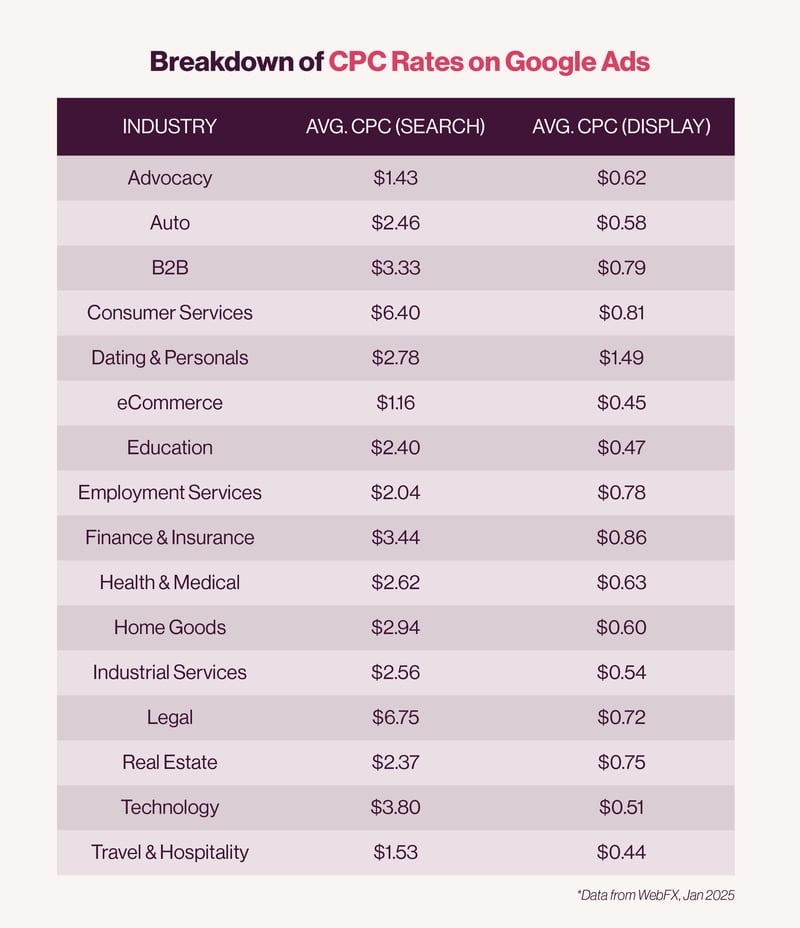
These benchmarks provide a good baseline. But your own costs can still vary based on local competition levels and other specific factors for your business. Understanding where you fit in this landscape is key!
Current consumer trends
Stay ahead of the curve! Evolving consumer habits and how they shop impact your ad spend. If your audience flocks to new platforms or changes buying behaviors, your budget needs to adapt to maintain visibility.
Customer buying cycle
Cost is related to your target audience's purchase journey. If you're narrowing your scope by only targeting customers in-market or ready to buy, you're likely to get away with a smaller budget. But if you're nurturing leads through a complex sales cycle, you'll need a bigger budget to cover multiple touchpoints.
Account management
This one's simple — do you have the expertise to manage your Google Ads in-house, or are you better off leaving it to the pros? Going the DIY route on a shoestring budget may seem cost-effective upfront, but often leads to wasted ad spend down the line. Partnering with experienced professionals ensures your budget is optimized from the get-go.
Types of Google Ads
Understanding Google Ad formats is key to budget planning. Here's a quick guide:
- Search Ads (text-based): Appear on Google searches for relevant keywords. Highly targeted and costlier due to reaching purchase-ready audiences. Often responsive, meaning Google will automatically test different combinations of text to learn and serve which ones perform best.
_800px.png?width=386&height=216&name=searh%20ads%20(text-based)_800px.png)
- Display Ads (visual banners): Show across websites, offering broad reach but potentially lower cost per click. Can also be responsive, generating different combinations of text and images to fit across multiple ad spaces.
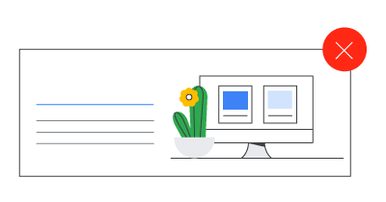
- Shopping Ads (product-focused): Entice high-intent shoppers with images and details. Costs vary by product category competition.
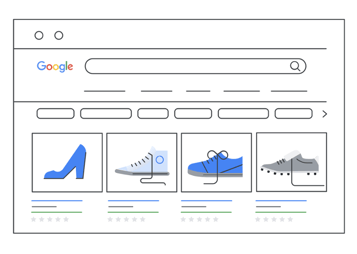
- Video Ads (engaging videos): Play on YouTube, with costs based on format and targeting. Great for brand awareness.
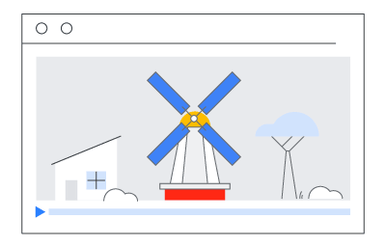
- App Ads (promote mobile apps): Drive app installs, with costs depending on app category and target audience.

- Call-only ads (drive phone calls): These ads only will only appear on devices that can make phone calls.

The best mix for you depends on your goals and customers. Generally, competitive placements driving sales (search ads) require higher budgets compared to awareness-building formats (video ads). Remember, a strategic ad format mix is key to optimizing your budget for maximum impact.
Bidding strategies
Your bidding strategy directly impacts your Google Ads costs. Each user interaction (click, view, conversion) triggers a charge based on your set maximum bid. So, choosing the right approach is crucial.
Here's a breakdown of the two main paths:
- Manual Bidding: You're in the driver's seat, setting max bids for each ad and keyword. This is perfect if you already know which terms are your top performers deserving of a bigger budget slice.
- Automated Bidding: Let Google's smart algorithms do the heavy lifting, automatically adjusting bids based on the likelihood of a click or conversion. It's all about aligning your bidding with your campaign goals, whether that's maximizing clicks, targeting a certain ad position, or hitting a specific cost-per-acquisition.
Within automated bidding, you'll find subcategories like:
- Maximize Clicks: Aims for the most clicks within your budget (great for traffic, but conversions aren't guaranteed).
- Maximize Conversions: Gets the most conversions (best for businesses that value all conversions roughly equally).
- Maximize Conversion Value: Gets the highest total conversion value (best for businesses that have significant variation in conversion values).
- Target Impression Share: Gets your ad on top page positions, but costs fluctuate based on competition.
- Target Cost-Per-Action (CPA): Optimizes for conversions while keeping costs below a set amount (helps stay within budget while capturing leads).
- Target Return-On-Ad-Spend (ROAS): Optimizes for conversions while keeping costs below a set amount (helps stay within budget while capturing leads).
Ultimately, the right bidding strategy depends on your unique business goals and resources. But by understanding these different approaches, you'll be better equipped to make an informed decision that maximizes your ad budget ROI.
Google's algorithm updates
Let's not forget who dictates the rules: Google's ever-evolving algorithm. These updates can impact your ad costs in a few ways:
- Benchmarks in flux: Google's algorithm changes can shift historical benchmarks like your cost-per-click (CPC) and cost-per-acquisition (CPA) data, which are used to set your bids. This can make cost projections less reliable.
- Policy shifts: Updates to ad approval, positioning, and measurement rules can affect your ad performance and impact your budget.
- Targeting tweaks: Major algorithm changes can overhaul how ads are targeted, displayed, and attributed. This can lead to unexpected swings in pricing if you're not keeping pace with Google's updates.
The bottom line? Staying informed about Google's latest moves is crucial to avoid unpredictable and potentially wasteful ad spend.
Average benchmarks for search
Understanding current industry benchmarks is critical for setting realistic ad budgets. While averages vary across businesses, the general landscape looks like this:
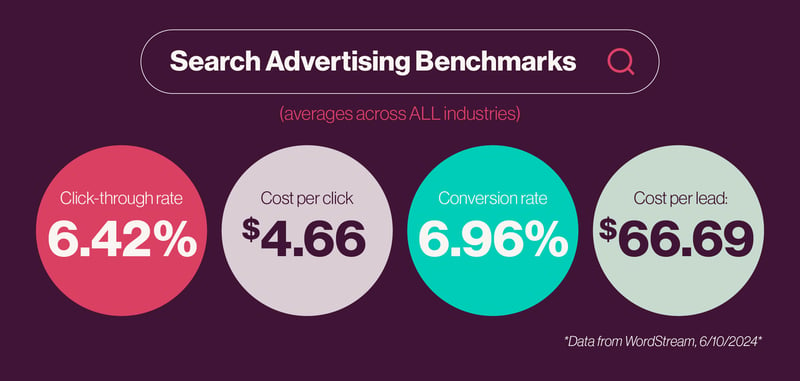
Use these figures as a starting point for gauging a reasonable cost range for your ads. But remember, tons of specifics factor into where your actual numbers will land!
How your CPC is calculated
 Now that we've covered the baseline, let's dive into what ultimately determines your unique CPC. Three key components make up the formula:
Now that we've covered the baseline, let's dive into what ultimately determines your unique CPC. Three key components make up the formula:
1. Keyword selection
Super specific keywords like "buy blue Nike running shoes" tend to cost more. Think about it — those searchers are close to buying, so competition is high. Broader terms like "running shoes" will be cheaper, but may not reach the most qualified leads.
2. Ad rank and quality score
Google's ad auction favors relevant and helpful ads. The higher your quality score (based on ad relevance and user experience), the lower your costs.
3. Optimization tactics
Smart audience targeting, compelling ad copy, and strategic campaign management can all significantly improve your cost efficiency over time.
Strategies to get the best CPC
Speaking of optimization...when it comes to making your ad budget work harder, you need a few killer tactics up your sleeve. Here are some of our favorites:
Continuous optimization
The key to a low CPC is constant monitoring and adjustment. We analyze ad performance across devices, demographics, and more. If a specific audience isn't converting, we shift focus. But for those converting at high rates? We double down to maximize return.
Audience targeting
Gone are the days of scattershot advertising. Modern platforms let us target the exact customer segments most likely to convert. This means prioritizing high-value leads and ditching those unlikely to convert — even if it means a temporary bump in CPC. You'll win big in the long run with skyrocketing conversion rates.
Relevant landing pages
The perfect ad can fall flat if the landing page doesn't live up to the hype. We ensure a smooth transition by mirroring ad messaging, addressing user intent, and creating a clear path to conversion. Each hard-earned click deserves a shot at becoming a loyal customer.
Geotargeting
Sometimes, geographic targeting is the key. We pinpoint the markets that are proven goldmines for your business, ensuring our clients' budgets prioritize those areas. No more wasted spend on irrelevant locations — just laser focus on where it matters most.
Device and ad format
Not everyone interacts with ads the same way. We analyze engagement data to understand if an audience prefers mobile, desktop, or specific ad formats like video. By concentrating on these top performers, you can maximize the reach and effectiveness of your budget.
Creative refreshes
Even the most captivating ad loses its charm over time. We regularly test new creative concepts, visuals, and messaging against existing ads. Proven winners become the new standard, constantly driving down your CPC.
Your ads aren't guessing games—they're revenue engines
 Enough hypotheticals about effective ad budgets. Let's transform your paid spending into a finely-tuned revenue engine tailored for your business's unique dynamics.
Enough hypotheticals about effective ad budgets. Let's transform your paid spending into a finely-tuned revenue engine tailored for your business's unique dynamics.
We go beyond basic analysis. Our experts delve deep into your data, customer journeys, competitor landscape, and overall marketing strategy. We leave no stone unturned to understand what drives sustainable growth for your brand. Because our mission is your revenue takeoff.
Ready to experience the power of Google Ads and leave the competition in the dust? You know what to do next.

